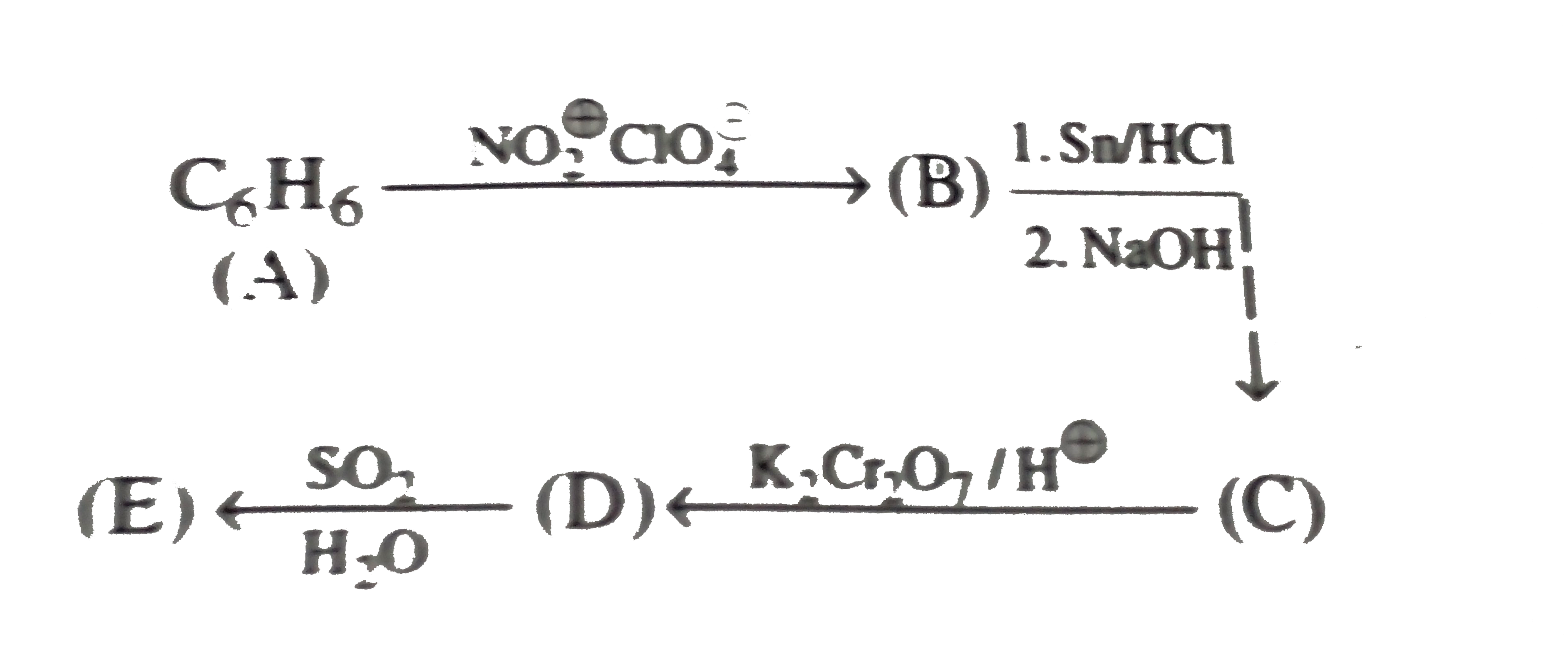complete the following reactions:
a. C6H6+MeCOCIBenze≠(A) AICI3−−−→ B HNO3––––––H(2)SO4)→ C NaBH4−−−−→ D H2SO4−−−→Δ E
To complete the given reactions step by step, we will analyze each step of the reaction sequence and identify the products formed at each stage.
1. Step A: Acylation of Benzene
- Reaction: Benzene (C₆H₆) reacts with acetyl chloride (MeCOCl) in the presence of aluminum chloride (AlCl₃).
- Product: The product formed is acetophenone (C₆H₅C(=O)CH₃), which is compound B.
- Equation:
C6H6+MeCOClAlCl3−−−→C6H5C(=O)CH3(B)
2. Step B: Nitration of Acetophenone
- Reaction: Compound B (acetophenone) is treated with a mixture of nitric acid (HNO₃) and sulfuric acid (H₂SO₄).
- Product: The nitro group (NO₂) will be introduced at the meta position due to the electron-withdrawing nature of the carbonyl group. The product formed is meta-nitroacetophenone (C₆H₄(NO₂)C(=O)CH₃), which is compound C.
- Equation:
C6H5C(=O)CH3HNO3/H2SO4−−−−−−−−−→C6H4(NO2)C(=O)CH3(C)
3. Step C: Reduction of Nitro Compound
- Reaction: Compound C (meta-nitroacetophenone) is reduced using sodium borohydride (NaBH₄).
- Product: The nitro group is reduced to an amine group, resulting in meta-aminoacetophenone (C₆H₄(NH₂)C(=O)CH₃), which is compound D.
- Equation:
C6H4(NO2)C(=O)CH3NaBH4−−−−→C6H4(NH2)C(=O)CH3(D)
4. Step D: Dehydration to Form Styrene
- Reaction: Compound D (meta-aminoacetophenone) is treated with sulfuric acid (H₂SO₄) and heated.
- Product: This leads to the elimination of water, resulting in the formation of meta-nitrostyrene (C₆H₄(NO₂)CH=CH₂), which is compound E.
- Equation:
C6H4(NH2)C(=O)CH3H2SO4,Δ−−−−−−→C6H4(NO2)CH=CH2(E)
Final Summary of Products:
- A: Benzene
- B: Acetophenone (C₆H₅C(=O)CH₃)
- C: Meta-nitroacetophenone (C₆H₄(NO₂)C(=O)CH₃)
- D: Meta-aminoacetophenone (C₆H₄(NH₂)C(=O)CH₃)
- E: Meta-nitrostyrene (C₆H₄(NO₂)CH=CH₂)
- Reaction: Benzene (C₆H₆) reacts with acetyl chloride (MeCOCl) in the presence of aluminum chloride (AlCl₃).
- Product: The product formed is acetophenone (C₆H₅C(=O)CH₃), which is compound B.
- Equation:
C6H6+MeCOClAlCl3−−−→C6H5C(=O)CH3(B)
- Reaction: Compound B (acetophenone) is treated with a mixture of nitric acid (HNO₃) and sulfuric acid (H₂SO₄).
- Product: The nitro group (NO₂) will be introduced at the meta position due to the electron-withdrawing nature of the carbonyl group. The product formed is meta-nitroacetophenone (C₆H₄(NO₂)C(=O)CH₃), which is compound C.
- Equation:
C6H5C(=O)CH3HNO3/H2SO4−−−−−−−−−→C6H4(NO2)C(=O)CH3(C)
- Reaction: Compound C (meta-nitroacetophenone) is reduced using sodium borohydride (NaBH₄).
- Product: The nitro group is reduced to an amine group, resulting in meta-aminoacetophenone (C₆H₄(NH₂)C(=O)CH₃), which is compound D.
- Equation:
C6H4(NO2)C(=O)CH3NaBH4−−−−→C6H4(NH2)C(=O)CH3(D)
- Reaction: Compound D (meta-aminoacetophenone) is treated with sulfuric acid (H₂SO₄) and heated.
- Product: This leads to the elimination of water, resulting in the formation of meta-nitrostyrene (C₆H₄(NO₂)CH=CH₂), which is compound E.
- Equation:
C6H4(NH2)C(=O)CH3H2SO4,Δ−−−−−−→C6H4(NO2)CH=CH2(E)
- A: Benzene
- B: Acetophenone (C₆H₅C(=O)CH₃)
- C: Meta-nitroacetophenone (C₆H₄(NO₂)C(=O)CH₃)
- D: Meta-aminoacetophenone (C₆H₄(NH₂)C(=O)CH₃)
- E: Meta-nitrostyrene (C₆H₄(NO₂)CH=CH₂)
Topper's Solved these Questions
- ALCOHOL,PHENOL AND ETHERSBOOK - CENGAGE CHEMISTRY ENGLISHCHAPTER - ALCOHOL,PHENOL AND ETHERSEXERCISE - Exercises Subjective
25 Videos
- ALCOHOL,PHENOL AND ETHERSBOOK - CENGAGE CHEMISTRY ENGLISHCHAPTER - ALCOHOL,PHENOL AND ETHERSEXERCISE - Exercises Concept Application
33 Videos
- ALCOHOL,PHENOL AND ETHERSBOOK - CENGAGE CHEMISTRY ENGLISHCHAPTER - ALCOHOL,PHENOL AND ETHERSEXERCISE - Archives Analytical And Descriptive
15 Videos
- ALIPHATIC AND AROMATIC ALDEHYDES AND KETONESBOOK - CENGAGE CHEMISTRY ENGLISHCHAPTER - ALIPHATIC AND AROMATIC ALDEHYDES AND KETONESEXERCISE - Archives Subjective
26 Videos
Similar Questions
Identify the following compounds :
i. C6H6(A) 2H2SO4−−−−→ (B) 1.NaOH,540K−−−−−−−−−→2.HCI (C)
ii.
View SolutionComplete the following reactions:
Benzene(A) Ac2O−−−−→+AICI3 (B) (i)MeMgBr−−−−−−−→(ii)H3O(+) (C) Conc.H2SO4 (D) 1.BH3/THF−−−−−−−−−−→2.H2O2/O(−)H (E)
View SolutionHNO3/H2SO4−−−−−−−−→ANaOH−−−−−→433KB, B is

View SolutionC2H2Hg(OH)21%−−−−−−−−−−→H2SO4A[O]−−→B, B is :
View SolutionComplete the following reactions :
C2H5OHConc.H2SO4−−−−−−−→160∘−170∘C
View SolutionComplete the following reactions:
PhCHO+CH3NO2ΘOH−−→Δ(A)
View SolutionComplete the following reactions:
(A)Glyoxal1.NaOH−−−−−→2.H3O⊕(B)
View SolutionComplete the following reactions :
CH3COOH+C2H5OHconc.−−−→H2SO4
View SolutionComplete the following reactions
CH3CH=CH2mCPBA−−−−→AC2H5MgBr−−−−−−→H3O+B
View Solution(A)(C4H8O)H3O⊕−−−→(B)CrO3−−−−−→acetic acid(C)CH2N2−−−→Δ(D)
The compound 'D' is
View Solution
